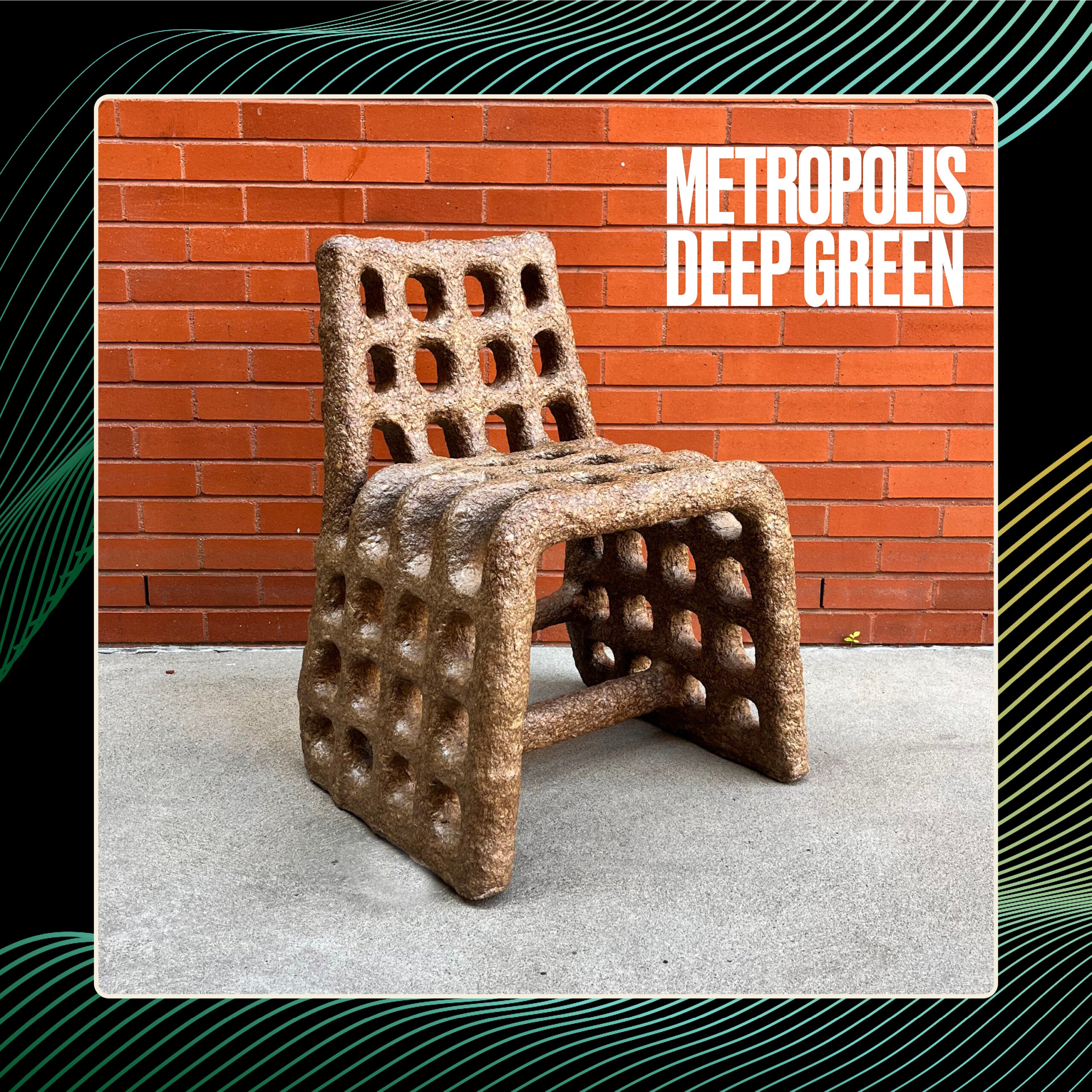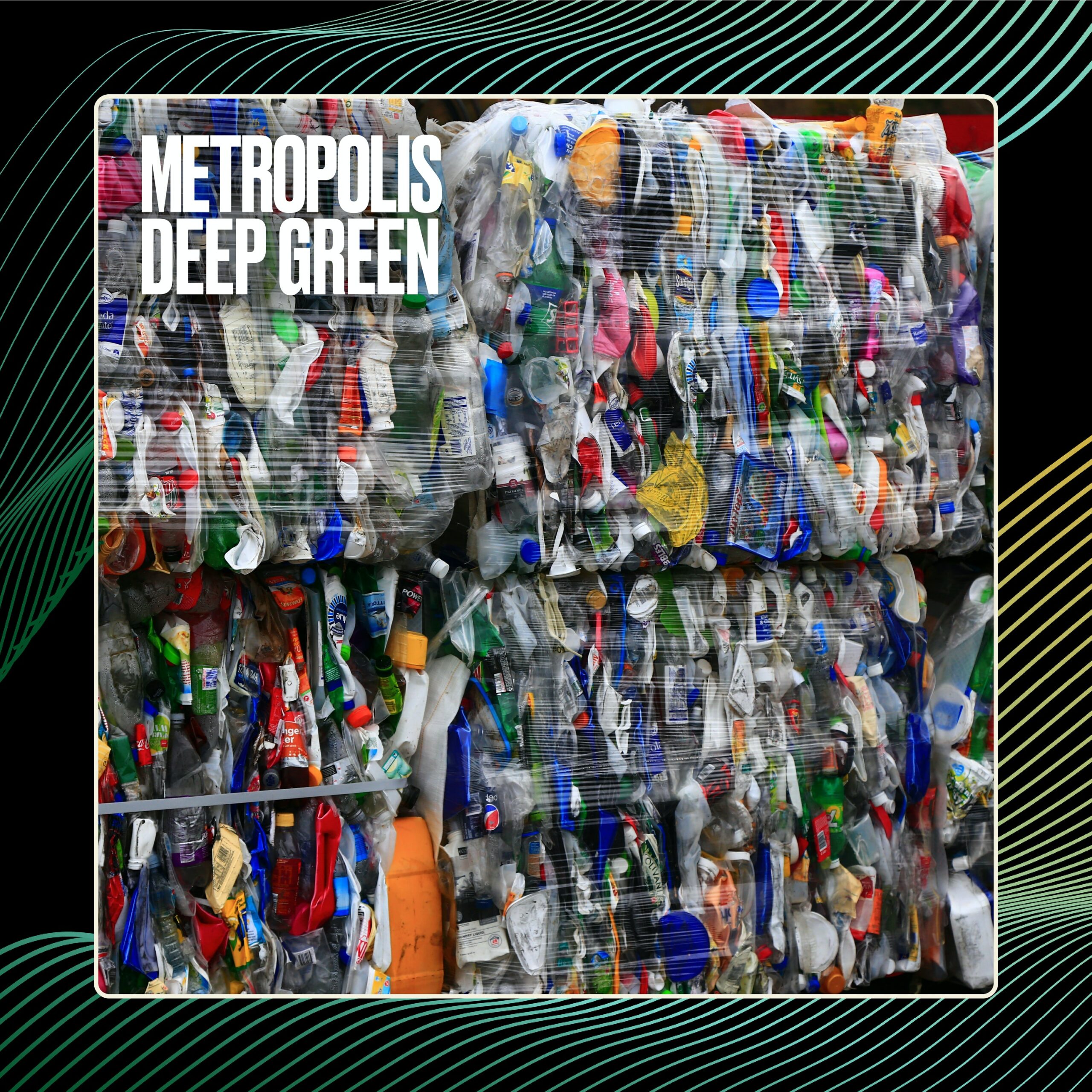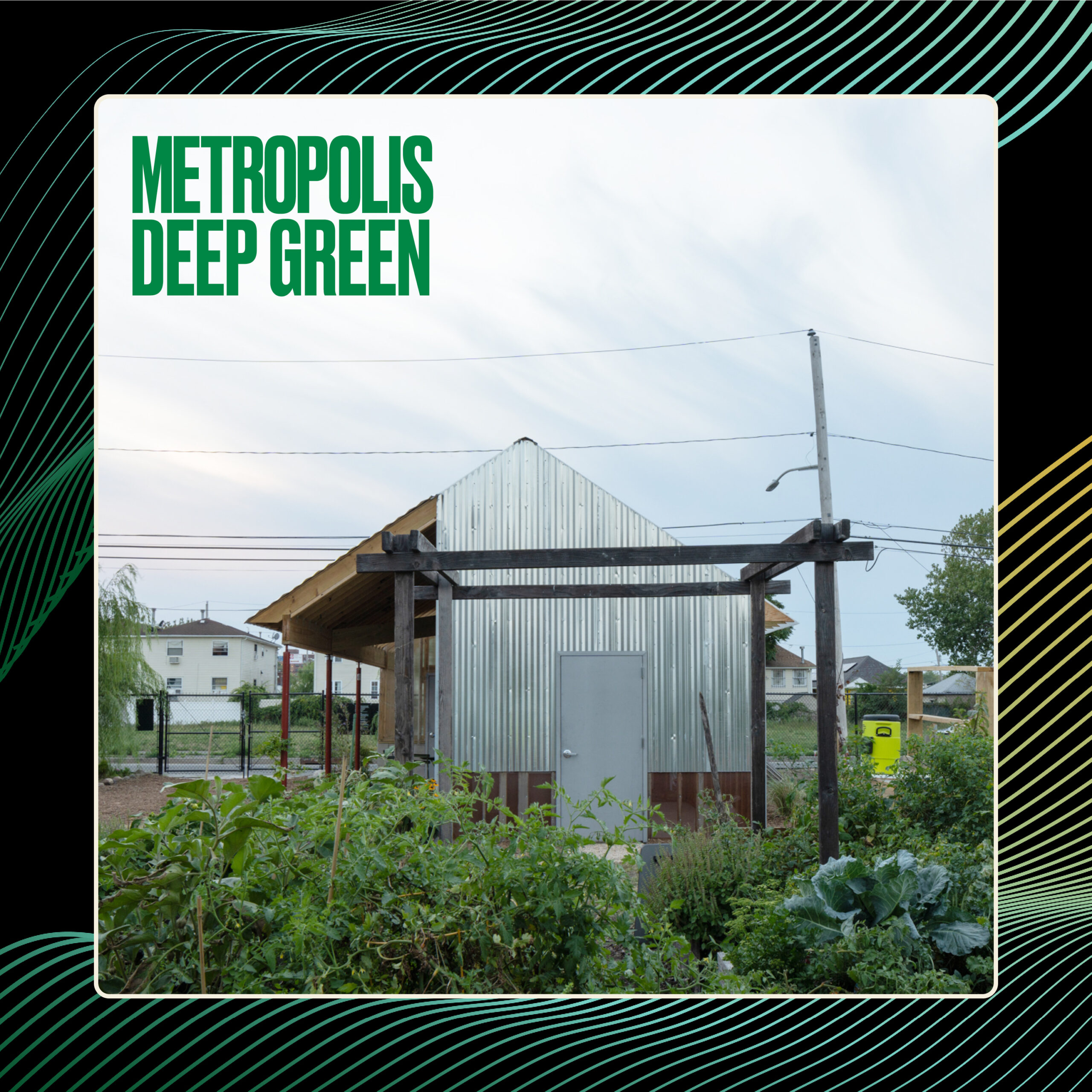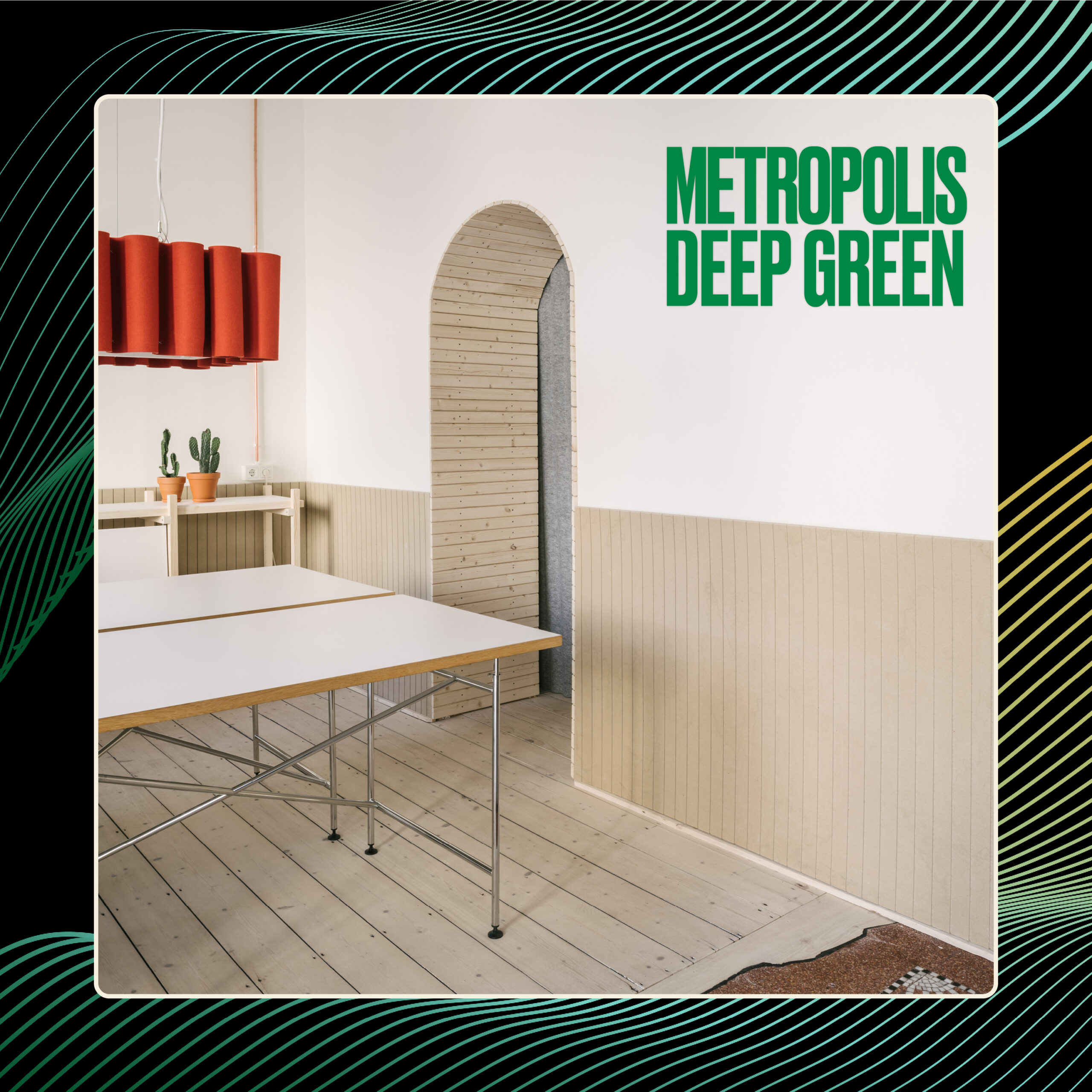If we want to fight climate change, improving or retrofitting an existing building often makes more sense than tearing it down and building a new one. But which buildings does it make sense to retrofit?
The Tower Renewal Partnership in Toronto argues that we should spend time retrofitting the buildings that make an impact in regular people’s lives: apartment buildings with affordable rents. The kind of buildings built with regular, mundane materials, where there are very small financial incentives or margins to make big improvements. The kind, in short, that are the toughest to retrofit.
Yet, architect Graeme Stewart and his firm ERA architects, which is behind the Tower Renewal Partnership, have done just that with the Ken Soble Tower in Hamilton, a Toronto Suburb. The 8-story high rise was built in 1967, and today it’s the largest Passive House–certified residential retrofit project in the world—and it offers affordable housing for senior citizens. In this episode, Metropolis Digital Editor Ethan Tucker speaks with Stewart to find out how the firm managed to make an affordable building sustainable.
Resources:
Connect with Metropolis:
Instagram: @metropolismag
Facebook: facebook.com/MetropolisMag/
Deep Green is a production of SANDOW Design Group.
[00:00:00] Avi: Welcome to Deep Green, a biweekly show about how the built environment impacts climate change and equity. Deep Green is brought to you by Metropolis. I’m your host Avi Rajagopal . Buildings are some of the biggest things we make as human beings. So if you want to know how we can do better for the environment and for all life on this planet, you have to understand buildings in cities and all the things that go into them.
[00:00:34] Avi: And that’s what we want to help you with here at Deep Green. Now, if you hang out. With architects who are working to make buildings more sustainable. And that’s pretty much most of what we do here at Deep Green, you will eventually hear a sentence that has become a sort of mantra in their circles. The greenest building is the one that has already been built.
[00:01:01] Avi: I’m gonna say it again. The greenest building is the one that has already been built.
[00:01:12] Avi: Now legend credits the sentence to architect Carl Elefante, who is president of the American Institute of architects and on the face of it, it makes a lot of sense. You see, it takes tons of energy and materials to build a building so much [00:01:30] energy. In fact, that about a quarter of the building industry’s carbon emissions are caused by construction and material.
[00:01:38] Avi: And that, by the way, in the United States translates to one 10th of all our carbon emissions as a country. So when someone decides a building is no longer useful, When they want to tear it down and build another one in its place, that’s a double or triple carbon impact. It means all of those emissions from when the building was originally built are now wasted.
[00:02:06] Avi: Plus there’s new emissions for the demolition process and then a whole lot of newer emissions for the new building. No matter how green that new building is. So you’re tracking with me so far. If we want to fight climate change, improving, or retrofiting an existing building often makes more sense than tearing it down and building a new one.
[00:02:32] Avi: But which buildings does it make the most sense to retrofit first? Ah, now that’s a tough question. The tower renewal partnership in Toronto argues that we should spend time. Retrofiting the buildings that make the most impact in regular people’s lives. You know, the kind of building that you and I probably live in most likely if you also live [00:03:00] in a big city and that’s an apartment building with affordable rents, the kind of building that was built with regular mundane materials, the kind where there are usually very small financial incentives or margins to make big improvements.
[00:03:20] Avi: The kind of building in short that is the toughest to retrofit. Yet architect, Graeme Stewart, and his firm ERA architects, which is the firm behind the tower renewal partnership have done just that with the Ken Sobel tower in Hamilton. A Toronto suburb. This eight story high rise was built in 1967 to be operated as subsidized senior housing by city housing Hamilton.
[00:03:51] Avi: But in all other regards, it was just like the hundreds of post-war suburban high rises that sprang up in the suburbs of Toronto in the 1950s through the 1970s. Now, however it is the largest passive house certified residential retrofit project in the world. That means it makes huge energy savings and offers 114 units of deeply affordable housing and 32 units of moderately affordable housing with rents below a thousand Canadian dollars per month for senior citizen.[00:04:30]
[00:04:30] Avi: Digital editor, Ethan Tucker, who wrote about this project from Metropolis mac.com is here with Graeme Stewart to find out how the firm managed to make an affordable building sustainable.
[00:04:46] Ethan Tucker: We recently featured a story on the Ken Sobel tower an 18 four affordable housing tower for senior citizens that your firm overhauled to meet passive house standards. And that renovation was really exciting for us because we often see these really high end dwellings and offices that boast incredible sustainability features, but simply put, they’re not designed for everyone they’re designed for the very top of the market.
[00:05:09] Ethan Tucker: And if we’re going to decarbonize the building industry, we need to be building greener at every level. In that way this project confronts the twin crises of climate and affordability. Something that I know your office has been thinking a lot about with the tower renewal partner. That’s why we wanted to have you on Deep Green today to talk about refits as a tool to tackle both carbon and affordability crisis, and to understand why your firm got involved with advocacy and shape and public policy to support these retrofits of which Ken is only one.
[00:05:42] Ethan Tucker: So thanks Graeme for coming on today. The first question I wanted to ask you is sort of about the unique situation in Toronto. There’s a housing affordability crisis across the US and Canada and virtually every major city. It seems around the world. What, [00:06:00] what is the particular situation in Toronto as regards housing affordability?
[00:06:05] Graeme Stewart: Well, thanks Ethan for having me on it’s a pleasure to be here. No good question. I mean, Toronto is not unique in having, uh, a housing crisis as is now the parlance. And I think that having been involved in this work for 15 years or so, this was very much under the radar, you know, it was coming, but it was very under the radar and now it’s become a fully understood front page of the newspaper type thing.
[00:06:27] Graeme Stewart: In terms of politics, housing affordability is now party neutral. Let’s. The situation in Canada is probably fairly similar to the us, but in the 2007, eight crash, Canada’s housing was relatively unaffected. So just housing prices kept on going up and up and up, whereas they dipped in the us. And there was an article that came out in the economist a few days ago that sort of said if the year 2000 is zero, that in the us, their housing prices have gone up like 150%. Canadian housing prices have gone up 350% and that sort of pegged with Nordic countries, Australia, New Zealand and Canada seem to be the most inflated let’s say. So part of the challenge is that just typical housing has become astronomically unaffordable to, to average people. And the, the housing that we focus on was built, you know, at tremendous scale in the sixties and seventies, through a variety of public, private partnerships, public policy, et cetera. That builts across [00:07:30] country, hundreds of thousands of these units in Toronto, there’s about 2000 buildings that we would consider to be high rise apartment buildings built during this era that are home to over a million people. And for the most part, this is where the affordable housing, you know, lies often. These are larger units, other type of units, people don’t build anymore, like three, four bedroom units. And that’s where, where a lot of families. And so it’s this housing that we’ve been focusing on and studying, you know, how did it come about what were the public, you know, policies that enabled them to exist and how do we make sure that they, they continue to exist? Uh, a lot of them are at the end of their first life. How do we give them another 50 years, another hundred years and don’t lose them from the housing system. Um, this includes nonprofit housing, social housing, and a lot of market housing. But housing people have generally similar, very low incomes. And so it’s, it’s, uh, become a major public policy piece. There’s been some huge successes, but a lot of work to. And we’re hopeful that the learnings from this can, you know, scale across country and also beyond beyond candidates to, to other international partners.
[00:08:34] Ethan Tucker: That’s that’s awesome. And I think something that you, you said is really important. These suburban high rise housing towers are not all subsidized or government housing. Do you wanna just tell us sort of the story about how, how this typology came to. In Toronto and, and how they became the defacto affordable housing stock?
[00:08:55] Graeme Stewart: Yeah. This is something that was an interest in my early career. And a lot of my, [00:09:00] you know, research work as an architecture student, and it was sort of dumb question, which is just like, why do we have so many of these building? And for whatever reason, it was a question that no one had really asked before.
[00:09:10] Graeme Stewart: So when I looked at all the secondary sources, like people who wrote books about Toronto, no one had written that book. And so all of the sources were either primary sources, like. Actual documents. We’re building this neighborhood. Here’s the planning report or secondary sources from the seventies that were all reactionary.
[00:09:27] Graeme Stewart: So there was a big movement of early rejection of modernism in Toronto. Jay Jacobs moved to Toronto in the late 1960s or 1970s. And so there, there became, um, almost a mythologized period in the history about the rejection of modernism, the rejection of these building. You know, local activism, a lot of really great work, you know, people canceling highways, people canceling big, big state projects.
[00:09:50] Graeme Stewart: And, and so what this really looked at is to say, okay, that’s, that’s interesting. That’s part of our history, but what about all the stuff we built before that, you know, and it was almost, you know, 20 years ago or so when first started sort of diving into this topic, I would describe it as there was a cultural amnesia.
[00:10:05] Graeme Stewart: No one, everyone understood these buildings were bad. No one understood why. No one thought about them. No one researched about them. They were just these sort of like invisible assets that let’s say the, the intelligence or the urban thinkers or the, even the, you know, the chief planner of the city at the time, it was just understood.
[00:10:20] Graeme Stewart: Like that’s bad planning. Let’s focus on new stuff. And we just started to ask really simple questions, which is like, what about these buildings now? What do we do with them in the future? What about [00:10:30] the hundreds of thousands of people who live there? And that, that really is how this initiative grew. And another piece is, did a lot of work with international partners and sort of came to understand that the, these buildings are not unique globally by any means.
[00:10:45] Graeme Stewart: Every, every country in the world has these building. When you go to most European countries, you know, the periphery of Paris, the periphery of Amsterdam, of London, of Moscow, of wherever, have these building. The US is a bit of an anomaly and that it doesn’t, you know, the absence of these buildings in suburban United States is actually the anomaly. It’s sort of the, it’s the, the exception that proves the rule in a sense, they’re still building this all over Asia, right? So it’s like this housing forum is like a meme that took over the world. And then the, the U the American experience, as you know, is mainly this housing outside of New York is central city block busting specifically from housing companies, you know, in Chicago or Detroit or wherever.
[00:11:24] Graeme Stewart: And what we found is that, that, that, that sort of bias, you know, Canada often looks to the south to say like, okay, what’s the latest in urban thinking. And what we sort of found is that because there’s no proxy in the US, there, there was no then solution, you know, there’s no solution to suburban Highrise, older private housing if they don’t exist you know. So we started looking at, you know, what is happening in Berlin and Amsterdam and, and, you know, Madrid, et cetera, and kind of developed a, a research network. And that’s sort of how the tower renewal partnership started. It was really where are the best ideas and how do we cherry pick those ideas to be relevant in a north American context, in a largely private sector context.[00:12:00]
[00:12:00] Graeme Stewart: And found that there’s a lot of amazing dynamic policies and that, that sort of culminated, I’d say with the LL winning the pritzker prize, right? Like suddenly this is high architecture. When we started 20 years ago, 15 years ago, this, this was off the radar. But to get to the point where you can have high architecture, there was 20 years of policy making 20 years of, you know, carbon policy of housing policy, etcetera, that kinda set, set the tone.
[00:12:24] Graeme Stewart: And so a lot of the work has been, how do we. Architecture is not yet possible because there’s, there’s just not the means to bring that level of investment to these buildings. So where do we start? How do we actually set the table around policy, create the political will create the economic conditions and, and that that’s in our practice is culminated in the cancel tower, which is fantastic.
[00:12:44] Graeme Stewart: You know, we’re so proud of it. Getting to that point. There’s been. You know, a dozen or so let’s say less ambitious buildings before that to get, to get to Ken Soble in the work now, you know, working with policymakers and, and, and others is how do we then scale it? You know, if we’re gonna meet our carbon objectives, as you’re saying our resilience objectives and our sustainability objectives, we have to do a lot more of this. So how do we make sure everything’s aligned?
[00:13:08] Ethan Tucker: I’m really interested in this idea of laying the groundwork for architecture. So what made you sort of decide to pivot in a way from architecture to the policy groundwork that makes architecture possible?
[00:13:18] Graeme Stewart: I Suppose, because it just seemed so obvious. Like this, this is an example where, you know, my reading and my understanding of the kind of history of, of tower retrofit, it really starts in Berlin. And it was the [00:13:30] unification of east and west Berlin. So like in, you know, 1990 and so many people in both east and west Berlin lived in, in buildings like this, but specifically in east Berlin. So it just became pragmatic. It’s like millions of people in Berlin live in these. And we need to both for unification goals, but then large, and then afterwards for carbon goals and everything else, we have to fix this housing up. And I remember, I think this is, this is a very ideological thing, cause I was really struck by having met colleagues who were a part of that work back then and, and talking to, to others that there, after reunification, there actually was some discussion around like, well, everyone, we should tear these buildings down because they’re bad and we should build good, good housing that looks more Western.
[00:14:10] Graeme Stewart: And I think that that’s sort of the conversation that happens in North America. There’s this sort of sense of like, what is good housing and who are the decision makers and what housing do they live in versus like what housing do other people live? And that’s when things were getting, you know, from puit I go to, to wherever, you know, the idea of ally tearing down these buildings.
[00:14:28] Graeme Stewart: And so I think long thinking that this is really a you’re demolishing the symbol of, you know, social challenge, but you’re not dealing with any of this. Systemic issues and the housing is rarely to blame. So I, I think that started really as I, if it’s an ideological or, or if there’s a challenge in paradigm, how do you just sort of counter that challenge?
[00:14:46] Graeme Stewart: And so a lot of the work that we did was working with residents, working with local NGOs, like United Way, who did thousands and thousands of interviews with people who call these buildings home. And the results were really the people, they like their buildings, they like their [00:15:00] flat, they like their neighbor.
[00:15:01] Graeme Stewart: They, you know, they generally like their neighborhood. They don’t like that their elevator breaks down. They don’t like that their, their window is drafty. So it became a, a real issue of how do we make pragmatic improvements? How do we not make ideological positions, which is actually telling someone that their home should be destroyed you know. And I think another piece that is interesting is just, is just how you started this conversation about like housing affordability crisis. I think in the nineties, there was sort of the idea that there was like spare housing, you know, you could actually say, well, I wanna tear this housing down and build something else for a variety of reasons where now we’re just, we’re just not there.
[00:15:35] Graeme Stewart: We just can’t afford to lose a single unit, let alone thousands of units and rebuild them then we’re, we’re already behind.
[00:15:41] Ethan Tucker: Right. That’s fascinating. So if, if the first level is talking with researchers and architects in other countries that have done this, uh, work like Scandinavian countries and Germany.
[00:15:54] Ethan Tucker: And then the next level is sort of doing the research on the ground with residents and sort of reframing these dwellings as, as not something negative at all, but something to be preserved. What’s sort of the, the next stage that you guys undertook, is it like reaching out to government?
[00:16:12] Graeme Stewart: Yeah. No. Good, good question. And I, I like that summary. Well, one of, one of the things that really kicked this off, and this is possibly difficult to repeat, but when the sort of initial research came, it was packaged in a way that was. Really a bit of a manifesto like it was to sort of say, this is a, this is an unrealized asset. [00:16:30] Like we have these buildings, the urban form of the city was based on the structure of having really mass housing and mass apartment housing as part of the formula that made Toronto work.
[00:16:38] Graeme Stewart: And then repackaging that and, and telling that story and sort of saying, this is a story that most people don’t really think about and the kind of six degrees of separation, like newcomers. To the city, which make up 50% of the population or grandparents were newcomers or people who were students and lived in a building, you can basically go to any room in the city.
[00:16:57] Graeme Stewart: And someone either lived in one of these buildings or their grandparents did, or their friend did or whatever. So, because of their ubiquity, they’re not othered. Like everyone participates in living in these buildings in some degree. And I think telling those stories really helped push it. The other one was then to overlay and talk about really sustainability and growth. And to say that leveraging these assets, to encourage new housing development, more mixed, use, more local economies to reduce car traffic and more smart transit planning. And, and really the idea of massive carbon advantage of, of retrofit because these buildings are running natural gas. Most of them were built with single pane windows, no insulation, et cetera.
[00:17:35] Graeme Stewart: So the, the bang for your buck for retrofit is substantial from a carbon perspective. So that was packaged and kind of put on the desk of the, of the mayor of Toronto. Well, actually I wrote a, I wrote an oped. In the kind of big Toronto daily and that got to the mayor’s desk and then the mayor wanted a briefing.
[00:17:50] Graeme Stewart: And then that accelerated the conversation. Let’s put it that way. so suddenly, suddenly the, the mayor’s office is saying, we need to make this a policy and that, that trickled down. And that, that [00:18:00] happened over 10 years ago. And so I would say that the real challenge has been the ambition that was sort of outlined in that original vision and the ambition of, of the mayor putting major political capital on the line to do it at that time.
[00:18:12] Graeme Stewart: Didn’t match. The capital required, you know, it’s like, we’re talking about multibillion dollar project. At that time, there was no money. There was just sort of an intention. And so that created the, the potential to then do all the kind of legwork around. What are the policies? What are the zoning, what are the tax changes?
[00:18:27] Graeme Stewart: What are the, those things that really the last 10 years have been about? And the big push is 2015 in Canada. When the Trudeau government won the election, there was a real push about housing policy as part of that platform and that initiated what’s called or what they call the national housing strategy, and it’s about building hundreds of thousands of more units, so affordable and, and et cetera. Hopefully we had some effect. We were part of the consultations and showed all the evidence, et cetera, and to make sure, make sure that retrofit was. Big a part of that agenda as building new and the idea that if we lose housing, we already have at any rate, let alone a rate greater than what we’re building new we’re never gonna catch up. So we have to keep what we have and then we have to build new. And that became a big part of the agenda. So currently a $15 billion fund, which is really focused on mainly non-profit housing to do retrofits. And it’s aligned with carbon goals. It’s aligned with accessibility and aging in place and all this stuff. And that suite of funding package. Is really what has enabled this sort of first generation of deep retrofits, mainly in the nonprofit sector. And now concurrent to that, [00:19:30] there’s something called the Canadian infrastructure bank. It’s kind of a big lender that is more commercial sector or private sector, but they’re able to do what we call.
[00:19:37] Graeme Stewart: I don’t know, the, the American term would be, we call like crown rate lending it’s whatever. Bank of Canada is with no, no top up, basically it’s like as cheap, cheap as money as you can possibly have. Didn’t matter a few months ago. Now it suddenly matters again with interest rates going up, but they’re able to, and their, their ambition is how do we bundle 200 million, 500 million kind of portfolio outlays. To the asset managers who run these buildings to actually do these deep retrofits. And there’s a whole series of carbon and other objectives sort of tied to this. And so that’s, that’s just scaling up and, you know, there’s, it’s that plus a whole bunch of other things that’ll make it happen, but it’s exciting to see the kind of financial side of this coming together. The kind of first tranche of really direct government investment to, to work with really struggling assets of, of public housing and get them where they need to be. And then the more systemic piece of what are the different levers to, to really push things. The other side of it. And I think a lot of us have seen this during COVID is, when we first started the built projects, the level of ambition around climate and resilience was much lower.
[00:20:34] Graeme Stewart: It was like, you know, can you save, you know, 20% energy or 20% carbon.dot dot. And now the, the net zero conversation has just accelerated dramatically. But now suddenly, in the city of Toronto, as there are, you know, in New York and, and Boston and other cities, there’s net zero targets for, for 2040 for the building stock.
[00:20:52] Graeme Stewart: It’s like 20
[00:20:53] Graeme Stewart: 40 is 18 years away. you know, so, so these programs are now recalibrating to basically say you need to be net [00:21:00] zero, ready to even get funding. So things, things are, things are happening quickly. Optimistically let’s let’s hope that the, the scaling starts, but the, uh, the pieces are starting to come together.
[00:21:09] Ethan Tucker: Yeah. That’s, that’s fascinating.
[00:21:12] Avi: Deep Green will be back after a short commercial break. This episode of Deep Green is brought to you in partnership with Caesarstone Caesar Stone’s outdoor collection, combines durability and performance with sustainability Yael Goldshmid senior marketing manager at Caesarstone is here to tell us more.
[00:21:30] Avi: Yael what’s so unique about your outdoor surface.
[00:21:34] Yael Goldshmid: Thanks Avi what’s really unique about our outdoor surfaces is first of all, it’s the only one in the market at Caesarstone is a litter of innovation. This countertop that we’ve produced is one of a kind, we are committed to continue innovating products and our outdoor collection is exactly that. We have it patented and it is the only quartz outdoor surface that’s currently available for outdoor use. It is a groundbreaking collection that provides convenience of stain resistance. Very easy to clean surface while really creating a high durable material that’s proven to withstand all elements of. Rain snow shine, very high temperature as above 50 celcius to very low temperature of below 30 celcius .It is really the answer to any outdoor solution. And [00:22:30] what’s very important is that the color that you chose will look like that for a lifetime. It will not fade. It will not yellow. Exactly the way you need it to be the way you picked it. That’s how it’s going to be for your life.
[00:22:44] Avi: What a great way to give us another way to commune with the outdoors.
[00:22:48] Avi: Tell us a little bit about Caesar Stone’s broader commitment to sustainability.
[00:22:51] Yael Goldshmid: Absolutely. Avi. So Caesar stone. Really talks about sustainability from multiple aspects. Of course, we have our products that is sustainable and we continue to innovate in that area and continue to produce more and more and more products that are sustainable we started it with our pebbles collection and we continue on with other products as well, but for Caesar Stone, it’s not just about the product. It’s also the way we operate. So it starts with, you know, the manpower that we source to manufacture our, our, our products, the way we transport our product. And of course, the way we dispose of our products.
[00:23:30] Yael Goldshmid: So we do have very aggressive claims about 25 of them that we’ve identified in our ESG report that was launched last year. I encourage everyone to take a read. It is a great read. It is on the website and learn a little bit more about commitment to sustainability, because like I said, sustainability is a trendy word right now, and a lot of other brands are using it from a product perspective.
[00:23:55] Yael Goldshmid: But here at C stone, we took it to another level. We treat it as our [00:24:00] own brand. We treat it as the way we operate and the way we live and breathe sustainability. So we take it very seriously.
[00:24:09] Avi: Thank you so much. Yeah. If you want to dive a little deeper into Caesarstone sustainability efforts, head on over to Caesarstone us.com.
[00:24:16] Avi: If you want to sample some of the amazing products in the outdoor collection, you can use the promo code outdoor pod that’s O U T D O O R. P O D outdoor pod on us.com
[00:24:35] Avi: Deep Green is back with part two of our episode, unaffordable and sustainable. Here’s Ethan Tucker, again, talking to Graeme Stewart about the passive house certified retrofit of the Ken Soble tower.
[00:24:50] Ethan Tucker: Maybe we can just talk for a second about sort of what the, what the potential is with these buildings for carbon, for carbon saving measures, why there’s such such a valuable target.
[00:25:01] Graeme Stewart: It probably really comes to scale like when you’re at a scale where there’s this, this sweet spot and a lot of these buildings fit that. So it’s sort of 10 stories. Plus some of the buildings are, are, are quite, quite enormous where you’re looking at a, you know, it’s a 30 story slab, but it’s got 500, 600 units in it.
[00:25:17] Graeme Stewart: So it’s, it’s like these are, can be quite large buildings from the, from the first instance, there’s just a lot of economies of scale in terms of make a robust envelope, then you’re able to dramatically downsize all of the heating and cooling [00:25:30] systems in terms of, you know, each home, the, the potential to do very low carbon at the end.
[00:25:35] Graeme Stewart: The result is, is high and relatively more efficient than let’s say was a whole bunch of single family homes. So there’s certainly, it’s almost like the first, it would be really the first place to start, because you can get such a bang for your buck in terms of the effectiveness. And also a lot of them have not had incremental improvements where with people’s homes, people insulate the roof, they change the windows.
[00:25:53] Graeme Stewart: There’s asymmetry as to where these different types of buildings are, where often in these buildings. They’re just, they’re just remarkable in how, how inefficient they’re. And a lot of that also has to do with this very cheap energy prices. I think we’re all learning to our horror, the challenge of what’s happening in Europe right now.
[00:26:07] Graeme Stewart: And when did a lot of research and work in Sweden and in Sweden, they said, well, we took our economy completely out of fossil fuels in the seventies, you know, really because of geopolitics, right? Like there’s a geopolitical reason to decarbonize in the EU, which has push those policies for the last 40 years where in north America and in Canada, like we get all of our natural gas from Alberta and it’s dirt cheap.
[00:26:28] Graeme Stewart: So there’s, there’s sort of a sense of total energy security. And when you actually look at the bills that these buildings spend on natural gas, they’re still very low. So it’s the most inefficient building in the world. It uses four or five times more carbon per square meter than a well built home but there’s no pain point to that. So that’s where it becomes, it becomes something else. And I think where what we have have found in the Hamilton project was a perfect example. Is that the carbon argument’s great. That’s great for policy. It’s great. It’s, it’s great for people like us, who, who really wanna advance climate change mitigation, but [00:27:00] really it comes down to comfort, but people are uncomfortable in these buildings.
[00:27:03] Graeme Stewart: They’re drafty. They can be moldy. They can be damp. They’re overheat in the summer. They’re uncomfortable in the winter, et cetera. And by doing a envelope first deep retrofit, you can dramatically improve comfort and that’s approach. We’ve taken with all the projects we’ve been able to, but especially Ken, so where it was opted to go house that it’s such a comfort.
[00:27:22] Graeme Stewart: Program and we introduced central cooling and dehumidification. We modeled the project on future 2050 weather conditions and to make sure that it would be comfortable and resilient in all of those in that future scenario. And then the byproduct is that you have a very low carbon or zero carbon building.
[00:27:37] Graeme Stewart: So it’s almost like. Start with comfort. And then the two things come together and it is possible to make a very low energy building that’s terrible to live in. you know, so you really wanna start with, start with comfort and then, and then go from there. So one of the things that’s just sort of fantastic about these buildings in a sense is that they were they’re actually quite well built.
[00:27:55] Graeme Stewart: They have very robust concrete frames. Most of them are block well, and then Mason re veneer. So they’re, you know, very stur. Construction and sturdy walls. So in terms of doing a retrofit, like replacing windows, putting on exterior insulation, doing internal mechanical, you have a good substrate. You have a good set of bones to work with other, other jurisdictions and, you know, different parts of the UK and elsewhere, they use these kind of prefab system buildings from the seventies, and those are the ones they found, like they just have to come down. They’re, they’re kind of falling apart anyway. So a good building stock and the, the way that I think the projects that are happening now, the way to sort of do the math, is it [00:28:30] really buildings at end of life, you have to replace all the systems, plumbing, et cetera, et cetera.
[00:28:34] Graeme Stewart: And you’re really looking at, do we tear the building down and replace it or do we do a deep retrofit? And in that context, it’s dramatically cheaper, like less than half the cost to do the deep retrofit than it’s to build. And that was the case at, at Ken Sobel, and that, and that includes full interior, fit out new kitchens, bathrooms, rearranging things, et cetera.
[00:28:53] Graeme Stewart: So it can get much cheaper than that. If you’re more targeted. And then in terms of embodied carbon, We worked with a, I worked with trans solar in a fantastic Vancouver based climate engineer JMV and, uh, embodied carbon analysis. And it was really surprising concrete in the, in the sixties. And seventies is really dirty.
[00:29:09] Graeme Stewart: It’s very energy intensive. It’s pre any kind of environmental policies and found that if we tore the building down and they built a new passive house, it would still take 180 years to pay back the loss of the embedded carbon in the concrete frame. So at that point it’s like, what’s all just window dressing there.
[00:29:25] Graeme Stewart: There’s, there’s no climate argument to do it. It’s just more like you feel good about yourself cause you do the or something. So that was very interesting. It, it makes a further argument as to why, especially in this particular building stock, there’s no reason to, to not keep what we have and give it another hundred years.
[00:29:40] Ethan Tucker: I think that’s, you know, that’s sort of the, the top line takeaway, right. Is, uh, it’s not worth knocking it. Just a couple more questions about the bridge between architecture and advocacy when you were getting started and doing this public policy advocacy, talking to elected officials, planning boards, things like that. If you felt like there was like an [00:30:00] architectural perspective missing from those conversations that, that your firm was able to contribute meaningful?
[00:30:06] Graeme Stewart: Yeah, I think it, I think it goes both ways. Like I also think that there’s a missing component to architecture, which is public policy economics, et cetera.
[00:30:13] Graeme Stewart: Right. Like it’s sort of, and that’s why it’s been really, really wonderful to be in this sort of between the two and a partner that works with me to lead this work A. Pinto is, is on, on parental leave right now. Otherwise she’d probably be on the call and she really leads a lot of that, that targeted research work.
[00:30:29] Graeme Stewart: And, and I think what’s really great about where we’ve land. Is, we were able to do architecture that was informed by policy and part of the work that we’ve done when we work with, with fantastic clients like city housing Hamilton, is that you’re helping them develop a performer. You’re helping them go to different parts of government to get the different funding and stack it.
[00:30:46] Graeme Stewart: And it’s not just, I have a brief, I’m gonna be an architect and I’m gonna do something dazzling. You know, it’s actually, you’re, you’re building, you’re helping to actually build the case for the project and, and all of those pieces. And then conversely, when you do build work and you see where the, the potentials for improvement are, we can then go that’s extremely targeted and actually based on pragmatic experience on the ground, we’ve, we’ve done a few pieces that have been really informed by built work. One is really looking at the, the retrofit ecosystem and saying what’s missing in terms of trades training, in terms of kits of part in terms of what are the products and what are the processes that would actually make better faster and cheaper. And that’s, that’s the part that’s so exciting. There’s such a growth opportunity in the full building ecosystem and to be able to really talk to [00:31:30] policy makers, as you’re saying, but from the perspective of someone who builds stuff, you know, we develop this sort of handbook for doing complex retrofits with residents in place.
[00:31:39] Graeme Stewart: And, and there’s just so much potential for dramatic improvement there from all sides. And for that piece of research, we partnered. A group in Germany, a group in the UK, a group in BC housing is a really big provincial housing authority that does amazing work and looked at examples of, of in our own work and then put together what’s the best process to undertake from all parties. You know, the perspective of the tenant, the owner of the constructor, as well as some really targeted recommendations of things that we can do better. One of the most interesting things that we took away, this is from the Oxford council in the UK, who’s done quite a bit of retrofits, cuz they’ve set it up so that the, the tenant board is actually part of the group that chooses the contractor. So I’ve definitely been on the other side as an architect where, where residents helps choose the architect. But I had never seen a before where they chose the contractor. And so the questions are well, what’s your customer service qualities? How are you you’re entering our homes? And what is your process for doing that? You know, what’s your communication plan. And it’s like those types of things that are so critical to retrofit on the ground that there’s so much room for. And there’s a lot of innovation happening out there. Solving those types of things is what’s gonna make the idea that we have to retrofit 10,000 buildings or whatever it is in the next decade possible.
[00:32:50] Ethan Tucker: We’ve talked so far, mostly about tower retrofits, but another big piece of your work has been. Liberalizing zoning in these sort of tower communities.
[00:32:58] Graeme Stewart: So, I mean, one, one of the big [00:33:00] picture things, and I don’t think we’re there yet. We’re, we’re getting there, but one of the big picture things would be to say, if we’ve inherited all of this, all of this latent density, there’s like there’s neighborhoods that have four or five very large towers often by like a forest. It’s kind of amazing some of these locations, but it’s incredibly isolated. And so there’s been a massive amount of, uh, transit investment in new Metro lines and all these things that are starting to happen and they’re finally starting to connect the dots on some of these outside neighborhoods.
[00:33:26] Graeme Stewart: So then the next step is, well then what is then the neighborhood vision for these places to be healthy communities, to, to have more density, to have a mix of use, but also critically to not lose the affordability that’s already there. And it’s a very hard problem. So I’d say that’s, that’s one of the things that’s currently being looked at.
[00:33:43] Graeme Stewart: Not necessarily solved, but is a priority of the city of Toronto and the housing policy people and growth planners and, and everything else. And what we’ve done is really provided a framework of that large scale opportunity and some granularity around what would at the end be a potentially good outcome. We partner with Toronto public health quite early on and United way to really look at. How do we create an evidence base for pretty dramatic policy change around land, use planning around these buildings and, and actually really tie it to social outcomes. When, when you wanna liberalize land use planning, people tend to think it’s just speculative developer lobby type of thing. And to really say like, well, no, this is grounded in public health objectives. And, and a lot of these neighborhoods, as you know, are they’re food deserts. They’re servicing deserts. They’re when they were, when they were first built, people would drive 15 minutes to the shopping [00:34:30] center. Now that car ownership is quite low in a lot of these neighborhoods, people have to take five buses or, or walk 45 minutes in the snow and be pretty, pretty dreadful. And so we worked with the city to do a top down rezoning of about 500 sites. And that was to. Really remove like an incredible list of prohibitions. And I don’t think these prohibitions were there out of people being malicious. It was just that they were kind of built in the sixties as these like resorts, you know, it’s sort of like they had a pool and they had saunas and they had tennis courts and, and they were surrounded by forests.
[00:34:58] Graeme Stewart: And they’ve just, they’ve just really changed. Like the buildings have stayed the same, but the demographics have changed and the needs of the buildings have changed. And you’d hear these, these stories of people having, I mean, essentially to do the, the most basic things, it’s technically breaking the, by-law. Or going to the landlord and saying, Hey, we wanna do X, Y, Z. What do you think? And then, then them saying, well, my lawyer tells me, I, I can’t, or are people wanting to do food services or after school education programs, like the most basic things. And that, that almost being tenuous, a shade of gray as to whether was allowed that big.
[00:35:29] Graeme Stewart: Across the board rezoning allowed for them to have the same amount of ability of mixed use as a, as a main street, as a main shopping street type of thing. So as of right, you can actually have small shops and small services and, and community centers and daycares. And we were actually able to work with, with Toronto housing and another, another firm who was the design architect on, on this was to actually build a daycare and to use the new, the new zoning where it’s like, it didn’t require rezoning.
[00:35:53] Graeme Stewart: It didn’t require, you know, even a site plan. Like it was just as a right. And, and to sort of see how to see. It worked was, [00:36:00] was fantastic. And then concurrent to that, there is a lot of pressure on these sites. Like there’s a lot of now condo developments and others where it’s like, great, there’s a, there’s a parking lot.
[00:36:08] Graeme Stewart: We’re gonna build this to be honest. We’re not yet at the point. And I’m optimistic we can get there where. There’s a clear set of expectations to say, yes, please develop the site. But this is the kit of parts that will make it a success. We’re still a little bit adversarial where it’s like condo developer wants this and, and community doesn’t want that to happen.
[00:36:27] Graeme Stewart: And it’s that there’s some late in frictions there, in some cases, the real leader in, in good outcomes has actually been Toronto housing where they’ve done a lot of developments on these sites with, as a mix of public and private housing. And some of them have been quite successful and I’m on designed a review panel for Toronto housing.
[00:36:42] Graeme Stewart: So seeing kinda what comes in the door and there’s a real dramatic improvement over the years of really thinking of how do we leverage these public assets. With commercial partners, but for public good. And another, another victory is region park as a, a famous neighborhood in Toronto. That’s many, many towers that have been demolished in the center of the city that started about 20 years ago.
[00:37:03] Graeme Stewart: There’s a lot of successes in what’s happened, but rhetorically it’s like tearing down these types of buildings and we’re, we’re actually working with we’re part of the team that includes car Carson’s architect from the UK to kind of master plan the last phase. And what’s interesting is that Regent park happened and those policies were set and it’s making the best new neighborhood it can be.
[00:37:21] Graeme Stewart: But out of that, and we’re part of, part of the advocacy. Toronto housing now has a policy that they don’t tear down existing buildings. Unless there’s been a full feasibility, unless you can [00:37:30] really prove that there’s carbon social and economic benefit to doing it. So it’s not to say that buildings that no buildings will come down, but it won’t be ideological where before it really was, these buildings were unpopular.
[00:37:41] Graeme Stewart: So it’s good for a politician to be seen to tear them down. Or I think that is now over. And we can be much more thoughtful about stewardship.
[00:37:48] Ethan Tucker: From your experience over the last 10 or so years, getting involved in public policy in order to lay the groundwork for this type of retrofit architecture, what would you say to other architects or other designers that are maybe ambivalent about getting involved in advocacy or policy political adjacent world in that way?
[00:38:08] Ethan Tucker: Do you have any thoughts on sort of what the architect’s role is there and, and whether that’s, overstepping or not overstepping?
[00:38:15] Graeme Stewart: Yeah it was founded before, before I started. And the, the founders, I think they were always political.
[00:38:26] Graeme Stewart: The role of the architect is expansive, but I think that historically, like the role of the architect is, is, is many, many things. So practicing architecture doesn’t necessarily just need to be. You get a program, you build a building. And in fact, we have to, I think of the practice really is you have to work to create the thing that you want to have happened.
[00:38:42] Graeme Stewart: Right. And it requires levers. And the other thing is a lot of the work we do is existing buildings and, and heritage and that type of thing. And the idea that you have to like what you’re working on. And I think part of the curiosity to look at these older modernist buildings that have a totally, you know, historically had such a terrible bias against them and actually [00:39:00] have the curiosity to say, well, someone love them. Someone designed them. What do people actually feel like? Who live there? Like the, to sort of peel away the layers of, of bias. You, you can’t fix what you hate. You can only improve things you love. And that’s kind of the ethic of, of the practice. I think there’s agency there. I mean, architects have such a position to then talk about how, how could things potentially be improved and advocacy, maybe capital a is one thing.
[00:39:23] Graeme Stewart: But I would just sort of say being a prudent practitioner, it would be to say, these are the variables that make a project. There’s the zoning policy. There’s this, there’s this funding thing. There’s this, that, which of those levers can we push in a way that would actually change the outcome of a project for the better.
[00:39:37] Graeme Stewart: When I think that every architect engages in that, in their own way, and that you can do it to dramatic effect, if you really sharpen the pencil and, and just keep at it.
[00:39:50] Avi: Deep Green is produced by Metropolis. I’m your host Avi Rajagopal. And this episode was reported by Ethan Tucker. The podcast is edited by Hannah Viti with support from Lauren Voker. You can read more about the Ken Sobel tower at Metropolis, mag.com. A big thank you to today’s guest and to all the folks at sand out design group who support Deep Green.
[00:40:17] Avi: We’ll be back again in a couple of weeks with another episode of Deep Green available, wherever you get your podcasts.[00:40:30]













